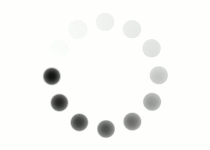Although T. adhaerens is very small, it is still a multicellular animal made up of thousands of cells. What's interesting is that even though it is an animal that is much smaller than sponges, it's slightly more complex and has two embryonic tissue layers--ectoderm and endoderm. Sponges are so simple that they don't have tissue. Also, T. adhaerens can be differentiated into two sides--ventral and dorsal.
What do ventral and dorsal mean? After you have your definitions, click the Show Me button to see if you're correct.

Ventral is bottom or belly side. Dorsal is back or top side.
Out of the thousands of cells that make up one T. adhaerens animal, biologists have discovered four different types of cells in this animal body. Two types make up the ventral side (endoderm), one type makes up the dorsal side (ectoderm), and the last type is found in between the endoderm and ectoderm layers. Click each tab in the activity below to learn about the different types of cells within T. adhaerens, where they are located, and what their cellular functions are.
Cylinder Cells
Gland Cells
Cover Cells
Fiber Cells
![By Todd Straus and Vladimir Osipov (BioMed Central) [CC-BY-3.0 (http://creativecommons.org/licenses/by/3.0)], via Wikimedia Commons](https://s3.amazonaws.com/cms.accelerate-ed.com/image/5dc43f2c-f09b-4d41-bd4f-0bbee6adbb5f.jpg)

Cylinder cells of T. adhaerens have a similar shape to this cylinder.
Cylinder cells are cylindrical-shaped, as pictured above, and have cilia, which are hairlike fibers that help the organism grasp and push against surfaces. Pictured is a cell with numerous cilia on the surface. Cylinder cells are monociliated, meaning there is only a single cilia per cell. Cylinder cells make up part of the endoderm and are located on the ventral surface.

The gland cells of T. adhaerens secrete digestive enzymes just like the cells in the human digestive organs secrete digestive enzymes to help break down foods.
Gland cells are more rounded than the cylinder cells and have more cilia. These cells are sandwiched in between the cylinder cells on the ventral surface of the animal's body. They play a role in digestion by secreting digestive enzymes. Together with the cylinder cells they make up the endoderm tissue layer.

The dorsal surface is made up of cover cells.
Cover cells are located on the dorsal surface of T. adhaerens and make up the ectoderm tissue layer. These cells are flattened near the surface, and, like the cylinder cells, they are monociliated.
Why do you think Trichoplax is translated into "hairy plate"? Once you have an answer, click the Show Me button to see if you're correct.

T. adhaerens is named "hairy plate" because all the cilia surrounding the animal's body looks like hair.

Fiber cells are star shaped, and are located in a mesh network between the endoderm and ectoderm layers. Biologists suspect that these star-shaped cells play the biggest role in allowing the animal to move and change shape.
What is the method of movement that T. adhaerens uses that is similar to amoebas? Click the Show Me button once you have an answer.

T. adhaerens and amoebas both move using pseudopodia or "false feet."
Jot down an answer to each of these questions--or say the answer to yourself--before clicking the question to check your understanding of the different cell types of Trichoplax adhaerens.
| How many cell types have scientists found to be present in T. adhaerens? | Four cell types have been found in T. adhaerens. |
| What two cell types make up the endoderm layer? | The gland cells and cylinder cells make up the endoderm layer. |
| What cell type makes up the ectoderm layer? | The cover cells make up the ectoderm layer. |
| Where are the fiber cells located? | The fiber cells are located in between the endoderm and ectoderm layers. |
| What is the function of the gland cells? | Gland cells aid in digesting food particles for the animal. |
| What is the function of the fiber cells? | The fiber cells help the animal change shape for movement. |
| What cells make up the ventral surface of the animal? | The gland and cylinder cells make up the ventral surface. |
| What cells make up the dorsal surface of the animal? | The cover cells make up the dorsal surface. |
| What are cilia and what cells have cilia? | Cilia are hair-like fibers located on the cylinder cells, cover cells, and gland cells. |
| How many total cells make up the body of an individual T. adhaerens? | Thousands of cells make up the body of T. adhaerens. |
